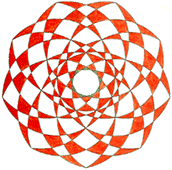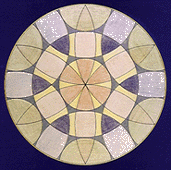|

|
Remo F. Roth
Dr. oec. publ., Ph.D.
dipl. analyt. Psychologe (M.-L. v. Franz)
|
 |
© 2005 by Pro Litteris, Zurich, Switzerland and Remo F. Roth, Zurich. All Rights Reserved.
dr.remo.roth@psychovision.ch .
Republication and redissemination of the contents of this screen or any part of this website are expressly prohibited without prior psychovision.ch written consent. This book is intended for private use only, and is copyrighted under existing Internet copyright laws and regulations.
With many thanks to Gregory Sova, Ph.D. and Patricia Sova (LA, CA) for translation assistance
The Archetype of the Holy Wedding
in Alchemy and in the Unconscious of Modern Man
Motto:
"Both of us [Pauli and Jung] seem to agree that the future of Jung's ideas is not with psychotherapy ... but with a unitarian, holistic concept of nature and the position of man in it."
(Wolfgang Pauli to Markus Fierz, 1950)
Index of Contents
1.
Introduction
2.
The Archetype of the Holy Wedding (coniunctio) in Alchemy
3.
The Alchemical Rosarium Philosophorum
3.1 The fountain of Mercury
3.2 The king, the queen, the dove as Mercury and the three flowers
3.3 Carl Jung’s interpretation: The archetypal child as the third
3.4 The archetypal child and the seal of Solomon as the fourth
3.5 The descent into the bath
3.6 The Holy Wedding or conjunction (coniunctio)
3.7 The death of the body and the creation of the spirit-psyche
3.8 Summary and further conclusions
4. “Rend the books lest your hearts be rent asunder” — Gerardus Dorneus’ unio corporalis and the matter-psyche as the shadow of the Self
4.1 The dew as matter-psyche and the bipolarity of the energy term
4.2 Carl Jung’s Neoplatonic interpretation of the unio corporalis and the Hermetic quintessence
4.2.1 The Neoplatonic interpretation of the subtle body as the realization of the personal typology and the personal shadow
4.2.2 The twofold aspect of the alchemical sublimation: The quaternarian consciousness and the Hermetic quintessence
4.3 The content of the Hermetic opus: The death of the Heavenly king
4.3.1 Carl Jung’s problem with the interpretation of the unio corporalis
4.3.2 The descent of the god and his death in the womb of the goddess
4.3.3 The death of the Heavenly king as the necessary condition for the creation of the quintessence or matter-psyche
4.4 Carl Jung’s divine/human double quaternity versus the Eros Self and the matter-psych
e
4.4.1 The depth psychologist’s Neoplatonic interpretation of the unio corporalis and the repression of conscious suffering
4.4.2 The coniunctio in the Christian Heaven
4.4.3 The Holy Wedding as the relationship of the Anima with the Self and of the ego with the Anima
4.4.4
Carl Jung's regressive mergence of the unio corporalis with the unio mentalis and the matter-psyche's principle as the way out
4.5 The relationship between the ego, the Anima, the Self and the anima mundi
4.5.1 The discrepancy between Carl Jung’s Anima and the anima mundi
4.5.2 Carl Jung’s exclusion of the Hermetic vegetative world soul (anima mundi)
4.5.3 Natural science and modern depth psychology as split from the wholeness of the anima mundi of the Medieval Ages
4.5.4 The Seal of Solomon as the anima mundi and as the modern solution of the Axiom of Maria Prophetissa
4.5.5 Logos ego, Logos Self, Eros ego and Eros Self
4.5.6 The Body-Centered Imaginatio
n - a first overview
4.6 The overcoming of Carl Jung’s Neoplatonic interpretation of the unio corporalis: The Hermetic matter-psyche as the shadow of the Logos Self
4.7 The structure and dynamics of a modern unio corporalis
4.7.1 The definition of the terms anima mundi, psychophysical reality, unus mundus and of their inherent dynamics
4.7.1.1 The ambiguous language as a condensation
4.7.1.2 The Hermetic alchemical unio corporalis as the background of a modern energetic terminology
4.7.1.3 The world soul (anima mundi), the psychophysical reality (W. Pauli) and the unus mundus (Dorneus/Jung) in my definition
4.7.1.4 The exchange of attributes, the double transformation process, the multiplicatio and the radiation
4.7.2 Comparision of the modern terminology with the Hermetic process
4.7.3 The progress of the modern concept compared with Hermetic alchemy, quantum physics and depth psychology
4.7.4 Consequences from the perspective of the psychology of religion
4.7.5 The relationship between the terms of my theory, Carl Jung's concepts and the concepts of modern physics [will follow]
4.8 Summary
4.8.1 The bipolarity of the energy term
4.8.2 The alchemical template for the energetic transformation process
4.8.3 Carl Jung’s unconsciousness of energy’s bipolarity and his reduction of the unio corporalis to the unio mentalis
4.8.4 Anima versus
anima mundi
4.8.5 Active Imagination and Body-Centered Imagination
4.8.6 The matter-psyche and the anima mundi as the Eros Self, the shadow of Carl Jung’s Logos Self
Chapter 5 of "Holy Wedding" will be published as a separate book. It deals with C.G. Jung's struggle in life and with his theory between 1895, the time of his seances with his cousin Helly, and 1928, the publication of "The Secret of the Golden Flower."
English Homepage Remo F. Roth
back

|